| |
|
|
 |
|
| From Eve to Mary: the Women of
the Bible |
|
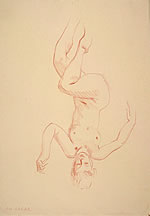 |
|
Studiy for the angel of Hagar |
| |
|
|
|
|
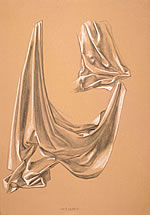 |
|
Study of drapery for Bathsheba |
| |
|
|
|
|
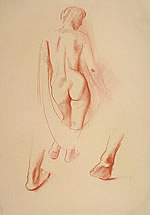 |
|
Study for Bathsheba |
| |
|
|
|
|
 |
 |
 |
 |
 |
|
| |
|
|
|
|
|
| Pictorial Cycle by Ernani
Costantini |
|
| |
|
|
|
|
|
| |
|
|
|
|
|
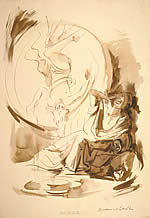 |
| |
Composition study for
Hagar |
|
|
During 1984 Ernani Costantini completed
the pictorial cycle called From Eve to Mary – The Women
of the Bible – consisting of twelve large canvases, all
two metres tall, but with different sized bases, measuring either
one, two or three metres.
The twelve female figures were chosen by the painter, from
among the many women of the Bible, “ … By allowing himself
to be guided by the suggestions of the Scriptures, and by the capacity
of the narrative events to evoke in his mind images, vivid atmospheres,
new evaluations, and also personal re-interpretations, on the one
hand as an undertaking to re-read the texts, on the other hand as
another expression of their communicative and narrative tension,
while exploring a territory where almost all connotations are of
a moral nature…”(1)
The practical process of producing
of the canvases was the result of years of reading, reflection, and
practice, which gradually led the painter to express, using his now
mature artistic technique, a complex narrative rich in artistic references
not only biblical but also based on a rich culture, assimilated over
a lifetime of the detailed interpretation of poetic and literary
texts and pictorial works.
“The cycle of women from the
Bible ran parallel with Costantini's work as a creator of large wall
paintings , especially in churches. In this new undertaking … Ernani
cultivated and nurtured his narrative vein and his ability to synthises
using large clear pictorial gestures, spacious, clearly visible and
comprehensible from a distance, marked, underlined, loaded with masterfully
enlightened atmospheric vibrations, syncopated and modulated as a
token of emotional and moral comprehension and participation.” (2) |
|
| |
|
|
|
|
|
|
|
|
|
|
| |
|
|
|
|
|
|
|
|
|
|
| |
|
The
twelve women are: |
|
|
|
|
|
|
| |
|
|
|
|
|
|
|
|
|
|
| |
|
|
|
|
|
|
|
|
|
|
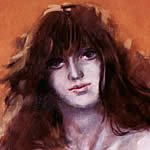 |
|
|
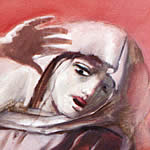 |
|
|
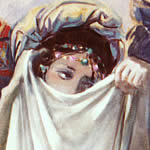 |
|
|
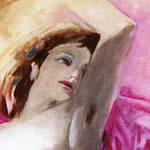 |
|
|
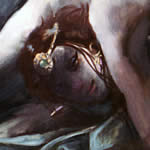 |
|
|
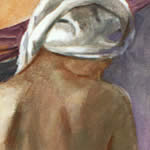 |
|
| |
|
|
|
|
|
|
|
|
|
|
|
|
|
|
|
|
Eve
… very modern, hair toufled … she is the first
woman…
… masterpiece
of the visible creation |
|
Hagar
… the Egyptian, mother of Ishmail...
… Abraham’s servant … |
|
Rebekah
… in her modesty, as evening approaches, she covers her face from Isaac’s
view. |
|
Potiphar's
Wife
… woman without a name, seductress of Joseph, who resists her advances. |
|
Delilah
… the deceitful one, in a greenish dusky light. |
|
Bathsheba
… statuesque figure object of David’s
desire … |
| |
|
|
|
|
|
|
|
|
|
|
|
|
|
|
|
|
| |
|
|
|
|
|
|
|
|
|
|
|
|
|
|
|
|
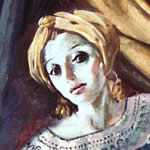 |
|
|
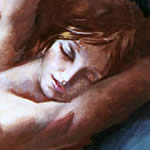 |
|
|
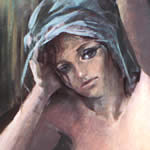 |
|
|
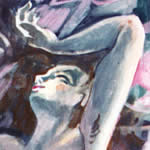 |
|
|
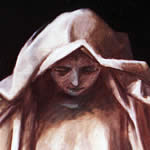 |
|
|
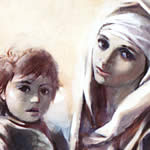 |
|
| |
|
|
|
|
|
|
|
|
|
|
|
|
|
|
|
|
Judith
… faithful to the law of Moses, victorious over Holofernes.
|
|
Shulammite
… the bride of the Song of Songs, she sleeps while her beloved
one spies from the window … |
|
Susanna
… symbol of virtue who resists violence, to reveal the malice of he who
observes her in secret … |
|
Salome
… she dances in a dark and somber place, while Herodias places the head
of John the Baptist on a tray.
|
|
Mary
of Magdala
… penitent, she emerges from the shadows and renounces her earthly goods,
broken at her feet.
|
|
Mary
of Nazareth
… mother of Christ, young woman and emblem of all motherhood.
(3) |
| |
|
|
|
|
|
|
|
|
|
|
|
|
|
|
|
|
 |
 |
 |
 |
 |
 |
 |
 |
 |
 |
 |
 |
 |
 |
 |
 |
 |
|
| |
|
|
|
|
|
|
|
|
|
|
| |
|
|
|
|
|
|
|
|
|
|
| |
|
|
|
|
|
|
|
|
|
|
| |
|
|
|
|
|
|
|
|
|
|
| |
|
|
|
|
|
|
|
|
|
|
| |
|
|
|
|
|
|
|
|
|
|
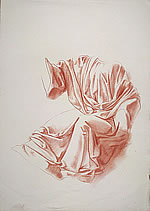 |
| |
Study for Hagar: drapery |
|
|
“Costantini
strips these twelve female figures of that aura which is a mix of the
mythical and the sacred in which history has cloaked them and returns
them to us in their human form which remains unchanged through time.
Twelve characters, twelve different situations, one common denominator:
the 'female dimension' … The artist once again succeeds in his
miraculous feat of speaking to us in a universal language…”.(4)
“The
pictorial achievement is one of rare consistency and expertise in
composing the twelve imposing paintings, with a concentrated effort
comparable to that of the great painters of ancient times with the
huge areas of the 'canvases' and the task of communicating through
painting, to a community which was attentive and spiritually ready
to grasp it, the analogical meaning between the image and the literary
text… Costantini's
bold attempt overcomes every hesitiation and returns to the origins
of this discourse”.(5)
Its completion after years of carefully pondered
readings and human and artistic reflection, was preceded by numerous
studies which were brought together in a sizeable collection of sketches
with varying dimensions and graphic techniques, splendid notes of
a personal creative process, rich and original, signs of great expertise
and technical prowess. Sanguine or charcoal, pastels, black and white
chalk, graphite, India ink and mixed-media, on paper of different
colours and various textures, deftly outline the images of figures
and objects, of faces, of general and detailed scenes, with these
details expertly brought together in the great scenes of the final
creation on the huge oil painted canvases. The influence of the sketches
on the finished version of the work is of such importance that Ernani
always accompanied the twelve canvases with a selection of studies
presented in their own introductory section of the exhibition itinerary. |
|
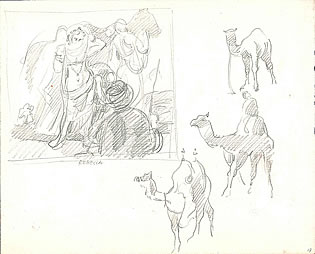 |
| |
|
|
|
|
| Preliminary sketches for
Rebekah |
| |
|
|
|
|
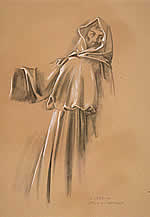 |
|
Study for Rebekah: Abraham’s servant |
| |
|
|
|
|
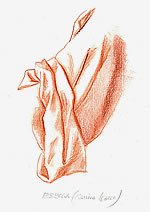 |
|
Study for Rebekah: Isaac’s sleeve |
| |
|
|
|
|
| |
|
|
|
|
| |
|
|
|
|
| |
|
|
|
|
 |
 |
 |
 |
 |
|
| |
|
|
|
|
|
| |
|
|
|
|
|
Preliminary studies for the
scene of Rebekah |
|
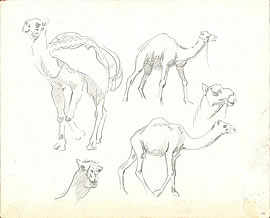 |
|
| |
|
|
|
|
|
|
|
|
|
|
| |
|
|
|
|
|
|
|
|
|
|
| |
|
|
|
|
|
|
|
|
|
|
| |
|
Completed between the end of 1984 and the
first few months of 1985, the twelve canvases were exhibited to the
public for the first time in Venice, at the Scuola Grande di San Giovanni
Evangelista from February 21st until March 15th 1987.
Later that same year they were exhibited at the Sala della Gran Guardia
in Padua from 13th to 31st December 1987.
The following year they arrived in Verona where they were exhibited
at the Palazzo della Gran Guardia from 5th to 20th March 1988.
On all these occasions the exhibition was accompanied by events and
debates on the subject of women, with the participation of Tina Anselmi,
Gigliola Cinquetti, Milena Milani, Claudia Mori, Elisa Tonello, Amelia
Casadei, Aloisa Dal Bò, Rossella Palopoli Bontempi, Elena Tuccio,
with Antonio Bruni and Giorgio Saviane acting as moderators.
Subsquently the canvases were exhibited at the Oratorio della Croce,
Cervarese (Padua) in July and August 1988.
The last time they were displayed in public was the exhibition held
at the Carlo dalla Zorza hall in the Carmini Art School
in Venice (now the M. Guggenheim Atrs High School) from the 26th September
to the 11th of October 2002.
A book was published about the Cycle, with reproductions of the twelve
paintings with a prologue including accompanying analytical texts by
Pietro Nonis, Giorgio Segato, Giorgio Saviane, Luigina Bortolatto,
Sergia Jessi Ferro and Guido Perocco, embellished with poems by Antonio
Bruni and passages from the Bible (edited by Multi Media Veneto MMV – Padua– 1987).
The wealth of copy written by critics in response to the cycle of paintings ‘From
Eve to Mary’, in newspapers and magazines, included articles
by: Paolo Rizzi, Piero Zanotto, Marco Goldin, Alberto di Graci, Giulio
Gasparotti, Milena Milani, Enrico Tantucci, Luigi Monti, Enzo Di Martino
among others.
Some television reports were also broadcast about the cycle.
In 1997 a full-length documentary was produced by the painter himself
and presented to the public at cultural evenings, in answer to some
enquiries he had received and provided background information about
the inspiration and reflections which motivated him to begin the project. |
|
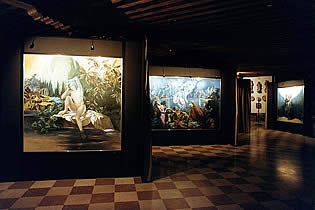 |
| |
|
|
|
|
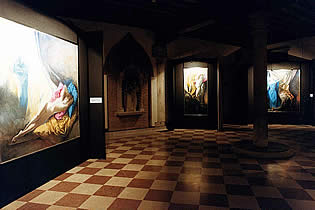 |
| |
|
|
|
|
 |
| |
|
|
|
|
| Above: the exhibition at the Scuola
Grande di San Giovanni Evangelista in Venice. |
 |
 |
 |
 |
 |
|
| |
|
|
|
|
|
|
| |
|
|
|
|
|
|
Study for Salome at Herod’s
banquet |
|
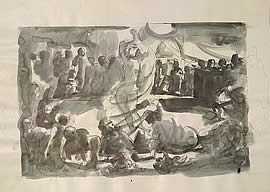 |
|
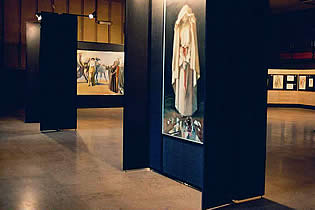 |
| |
|
|
|
|
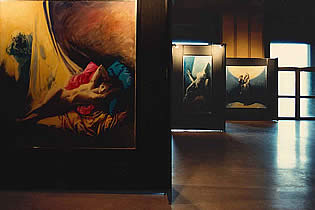 |
| |
|
|
|
|
| Above:
the exhibition at Sala della Gran Guardia in Padua. |
 |
 |
 |
 |
 |
|
| |
|
|
|
|
|
| |
|
|
|
|
|
| |
|
Notes
(1)^ (2)^ Segato, Giorgio, Il
ciclo Biblico di Ernani Costantini [The Biblical Cycle by Ernani
Costantini], in Da
Eva a Maria [From Eve to Mary], MMV, Padua, 1987
(3)^ The short phrases introducing the women are freely
adapted from the critiques written by various Authors published in From Eve
to Mary op.cit.
(4)^ Jessi Ferro, Sergia, Un messaggio spirituale
ed estetico [A spiritual and aesthetic message] , in Da Eva
a Maria op.cit.
(5)^ Perocco, Guido, Al di là della figurazione
[Beyond Representation],
in Da
Eva a Maria op.cit. |
|
| |
|
|
|
|
|
|
|
|
|
|
| |
|
|
|
|
|
|
| |
|
|
|
|
|
|
|
|
|
|
 |
 |
 |
 |
 |
 |
 |
 |
 |
 |
 |
|

